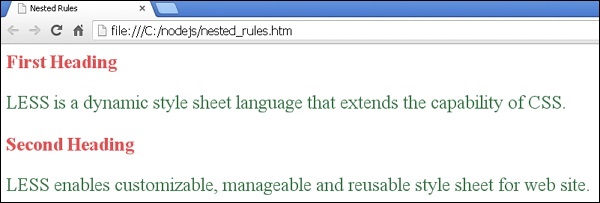
- Less - Nested Rules
- Less - Nested Directives and Bubbling
- Less - Operations
- Less - Escaping
- Less - Functions
- Less - Namespaces and Accessors
- Less - Scope
- Less - Comments
- Less - Importing
- Less - Variables
- Less - Extend
- Less - Mixins
- Less - Parametric Mixins
- Less - Mixins as Functions
- Less - Passing Rulesets to Mixins
- Less - Import Directives
- Less - Import Options
- Less - Mixin Guards
- Less - CSS Guards
- Less - Loops
- Less - Merge
- Less - Parent Selectors
- Functions
- Less - Misc Functions
- Less - String Functions
- Less - List Functions
- Less - Math Functions
- Less - Type Functions
- Less - Color Defination Functions
- Less - Color Channel Functions
- Less - Color Operation
- Less - Color Blending Functions
- Usage
- Less - Command Line Usage
- Using Less In The Browser
- Less - Browser support
- Less - Plugins
- Less - Programmatic Usage
- Less - Online Compilers
- Less - GUIs
- Less - Editors and Plugins
- Less - Third Party Compilers
- Less - Frameworks
- Less Useful Resources
- Less - Quick Guide
- Less - Cheatsheet
- Less - Useful Resources
- Less - Discussion
LESS - Nested Rules
Description
It is a group of CSS properties which allows using properties of one class into another class and includes the class name as its properties. In LESS, you can declare mixin in the same way as CSS style using class or id selector. It can store multiple values and can be reused in the code whenever necessary.
Example
The following example demonstrates the use of nested rules in the LESS file −
<html>
<head>
<title>Nested Rules</title>
<link rel = "stylesheet" type = "text/css" href = "style.css" />
</head>
<body>
<div class = "container">
<h1>First Heading</h1>
<p>LESS is a dynamic style sheet language that extends the capability of CSS.</p>
<div class = "myclass">
<h1>Second Heading</h1>
<p>LESS enables customizable, manageable and reusable style sheet for web site.</p>
</div>
</div>
</body>
</html>
Next, create the style.less file.
style.less
.container {
h1 {
font-size: 25px;
color:#E45456;
}
p {
font-size: 25px;
color:#3C7949;
}
.myclass {
h1 {
font-size: 25px;
color:#E45456;
}
p {
font-size: 25px;
color:#3C7949;
}
}
}
You can compile the style.less file to style.css by using the following command −
lessc style.less style.css
Execute the above command; it will create the style.css file automatically with the following code −
style.css
.container h1 {
font-size: 25px;
color: #E45456;
}
.container p {
font-size: 25px;
color: #3C7949;
}
.container .myclass h1 {
font-size: 25px;
color: #E45456;
}
.container .myclass p {
font-size: 25px;
color: #3C7949;
}
Output
Follow these steps to see how the above code works −
Save the above html code in the nested_rules.html file.
Open this HTML file in a browser, the following output will get displayed.
